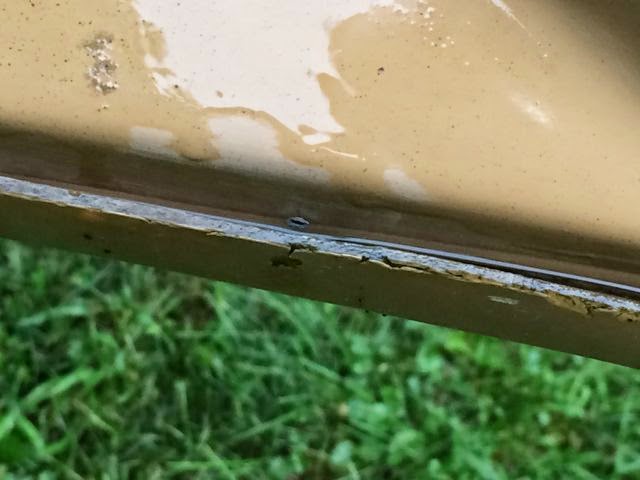Thursday's strategy session complete, I have a short list of the actions I'll be performing on the hull:
- Fill the void between deck and hull with marine grade epoxy putty.
- Fill the deep cracks.
- Reinforce and reshape the keel to original spec.
- Put a decent coat of resin on the hull.
- Finish coat with Gator Glide G4.
I started bright and early Saturday morning with a trip to West Marine. Once home, I set up shop and "pre-pared to re-pair."
The epoxy was, on the whole, easy to work with. It's very goopy without using water as a surfactant to keep it from sticking to goddamn everything. I started applying it with nitrile gloves on, but running it over the jagged edges of fiberglass quickly made doing so a moot point. It was clear that I was going to have olive green fingernails for the rest of the weekend.
I smoothed out the applied epoxy using water and my fingertips. A couple hours in, and I had the pruniest fingers ever. It took a couple hours to work epoxy into the void flush with the edge of the lip between the deck and hull. It also took a lot more material than I anticipated, leading to another trip to West Marine for more epoxy.
It took about three hours for the epoxy to fully cure. When it's still somewhat soft, it sands very easily, but will clog up sandpaper like nothing else. I then was forced to be done for the day due to a sudden downpour.
Sunday morning, with Saturday's rain still dripping off the craft, I set to sanding. Using a block and 60 grit sandpaper, I managed to smooth out about 1/8 of the lip in about a half an hour. It was clear that this was a job for an orbital sander.
The sander made quick work of the rough and uneven spots where the epoxy was applied. I was afraid of gouging the boat up with the sander, but with the slow start technology and variable speed, it was easy to start and stop sanding without over sanding. The dust collection bag was also a nice touch. It wasn't 100% dust-free, but it made a pretty sizable difference.
Once the lip was sanded, I was impressed with how much more solid that area was. Thinking back, I probably should have started with liquid epoxy to fully encase the interior of the void, but it looks like the marine epoxy putty is going to be pretty impermeable. It has adhered very strongly to all applied surfaces.
Remember, it used to look like this:
I then applied the epoxy putty to the keel to build it up back to original spec. I smoothed it out with a plastic spreader and water. It still took a significant amount of sanding to get the shape correct again. It's pretty close, and I think the next steps will even everything out even further.
Next steps: applying finishes to the hull. This will consist of a couple coats of West System 105, maybe with some barrier coat additive for further impermeability, then the Gator Glide.
Hopefully it's a bit less humid this week.
The sander made quick work of the rough and uneven spots where the epoxy was applied. I was afraid of gouging the boat up with the sander, but with the slow start technology and variable speed, it was easy to start and stop sanding without over sanding. The dust collection bag was also a nice touch. It wasn't 100% dust-free, but it made a pretty sizable difference.
Once the lip was sanded, I was impressed with how much more solid that area was. Thinking back, I probably should have started with liquid epoxy to fully encase the interior of the void, but it looks like the marine epoxy putty is going to be pretty impermeable. It has adhered very strongly to all applied surfaces.
I then applied the epoxy putty to the keel to build it up back to original spec. I smoothed it out with a plastic spreader and water. It still took a significant amount of sanding to get the shape correct again. It's pretty close, and I think the next steps will even everything out even further.
Next steps: applying finishes to the hull. This will consist of a couple coats of West System 105, maybe with some barrier coat additive for further impermeability, then the Gator Glide.
Hopefully it's a bit less humid this week.
















































